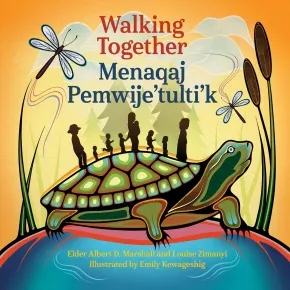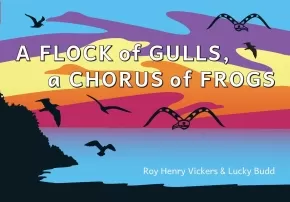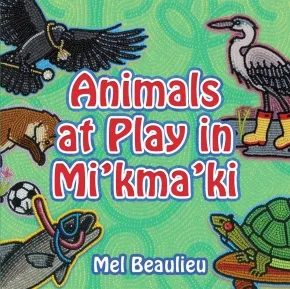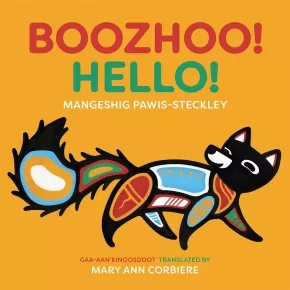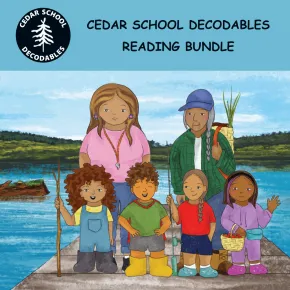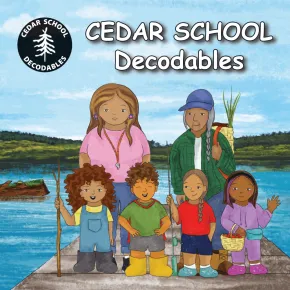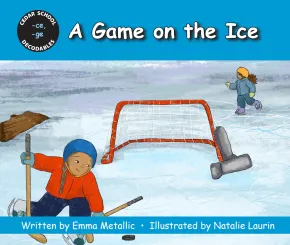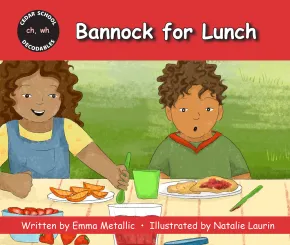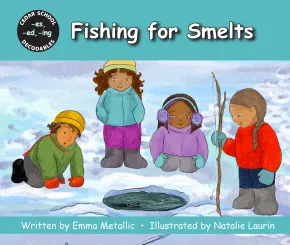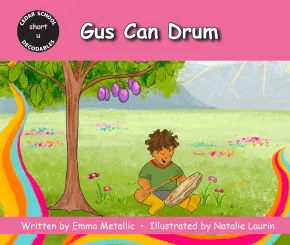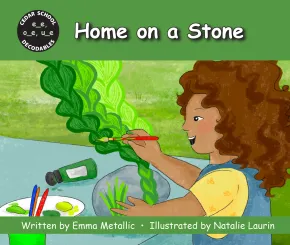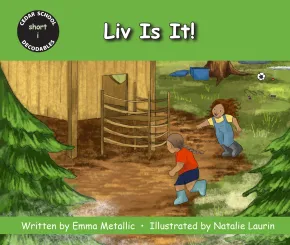
Literacy
46
-
60
of
699 Results;
Sort By
Go To
of 47
Walking Together / Menaqaj Pemwije’tulti’k
$24.99
Format:
Hardcover
Text Content Territories:
Indigenous Canadian; First Nations; Mi'kmaq (Mi'gmaq);
ISBN / Barcode: 9781834020174
Synopsis:
Synopsis:
This bestselling and award-winning introduction to Etuaptmumk—the gift of multiple perspectives also known as Two-Eyed Seeing—is now available in a bilingual edition that celebrates the Mi’kmaw language and our connections to nature.
Elder Albert D. Marshall is a leading environmental voice who has brought forward the concept of Etuaptmumk, honoring and braiding both Indigenous and non-Indigenous knowledges and ways of knowing for the benefit of all. Walking Together is grounded in this, as well as in the concept of Netukulimk, meaning to protect Mother Earth for the ancestors and for present and future generations. The journey in Walking Together nurtures respectful, reciprocal, responsible relationships with the Land and Water, with plant life and animals, and with other-than-human beings.
Translated by Barbara Sylliboy and Arlene Stevens, Eskasoni First Nation, Unama’ki (Cape Breton), Nova Scotia, the dual-language text in Mi’kmaw and English furthers Elder Marshall’s lifelong work preserving cultural beliefs and creating a strong vision for his people and for the future. Elder Marshall and Louise Zimanyi are working together to promote Land-based learning through storytelling, an approach that has global relevance for protecting biodiversity, climate action, and resilience. Emily Kewageshig’s evocative artwork illustrates the beauty of connecting with nature and encourages readers to strengthen their relationships to the world around them.
Educator Information
Recommended for ages 4 to 7.
Introduces the concept of Two-Eyed Seeing (the gift of multiple perspectives) to young readers.
Bilingual Edition: Mi’kmaw and English.
This book is available in English: Walking Together
Additional Information
40 pages | 9.00" x 9.00" | Hardcover
A Flock of Gulls, a Chorus of Frogs (BB)
$14.95
Format:
Board Book
Text Content Territories:
Indigenous Canadian;
Grade Levels: Preschool;
ISBN / Barcode: 9781990776502
Synopsis:
Synopsis:
Learn fun names for animal groups of the West Coast with a sturdy board book featuring the illustrations of Indigenous artist Roy Henry Vickers.
Bright blocks of colour and tactile embossed pages bring the natural world of the wild West Coast to life. Accompanied by a rhythmic, rhyming text, this board book will entertain babies, toddlers, and adults alike as they discover that orcas leap and dive in a pod, a bunch of sea lions are called a bob, geese make up a wedge, a swamp full of croaking frogs form a chorus, a jumble of jellies are called a bloom—and more!
A Flock of Gulls, a Chorus of Frogs is a vibrant addition to this bestselling, award-winning First West Coast Book series, perfect for storytime and supporting language development in babies and toddlers.
Educator & Series Information
This book is a part of the First West Coast Books series.
Recommended for ages 3 and under.
Additional Information
24 pages | 7.25" x 5.00" | Board Book
Animals at Play in Mi'kma'ki (BB)
$16.95
Format:
Board Book
Text Content Territories:
Indigenous Canadian; First Nations; Mi'kmaq (Mi'gmaq);
Grade Levels: Preschool; Kindergarten;
ISBN / Barcode: 9781459507449
Synopsis:
Synopsis:
In this fun board book for young kids, turtles skateboard, salmon snorkel, bears take photos and otters frolic with floaties!
Mi’kmaw artist Mel Beaulieu’s lively modern take on traditional beadwork brings these animals to life. Mi’kma’ki’s most iconic animals are portrayed in this colourful and whimsical book.
Mi’kmaw names (and pronunciation guides) make this a great introduction to contemporary Mi’kma’ki for very young children.
Educator Information
Recommended for ages 2 to 5.
Additional Information
6.53" x 6.53 | Board Book
Boozhoo! / Hello!
$21.99
Format:
Hardcover
Text Content Territories:
Indigenous Canadian; First Nations; Anishinaabeg; Wasauksing First Nation;
ISBN / Barcode: 9781773067155
Synopsis:
Synopsis:
Hello! Who do you see and hear in the woods today? Meet a variety of woodland and water animals in this story written in Anishinaabemowin and English.
Can you see a fox digging, spot two minnows dancing or hear a swarm of bees buzzing? Boozhoo! / Hello! introduces children to familiar animals as they go about their daily activities: walking, running, swimming, climbing and finally - when the day is done - sleeping! Illustrated in a vibrant and colorful woodland style that will appeal to readers young and old alike, and accompanied by an author's note.
Awards
- 2025 PMC Indigenous Literature Award Winner
Educator Information
Recommended for ages 3 to 6.
Dual-Language: Anishinaabemowin and English.
Translated by Mary Ann Corbiere.
Key Text Features: Author's note, translations, illustrations
Correlates to the Common Core State Standards in English Language Arts:
CCSS.ELA-LITERACY.RL.1.3
Describe characters, settings, and major events in a story, using key details.
CCSS.ELA-LITERACY.RL.1.7
Use illustrations and details in a story to describe its characters, setting, or events.
Additional Information
32 pages | 8.75" x 8.75" | Hardcover
Cedar School Decodables - Reading Bundle
 $958.80
$958.80

Grade Levels: Kindergarten; 1;
ISBN / Barcode: 9781771746571
Synopsis:
Synopsis:
Welcome to Cedar School! Join Liv, Tom, Gus, and Bell as they learn on the land and explore Mi’gmaw teachings with their teacher, Miss Sam, and the school’s Mi’gmaw Elder, Jen. With charming illustrations and simple storylines, this decodable series engages students as they practise their reading skills. Each book includes a pre-reading review of non-decodable words, and many of the books introduce special words related to Indigenous teachings. Talking Together prompts facilitate discussions led by the reading teacher.
Developed in partnership with Dyslexia Canada, Cedar School Decodables is a series of 20 decodable books for young readers. Designed for students who have previously learned short vowel and consonant sounds, additional phonic skills are developed progressively throughout the series. Cedar School Decodables is divided into six sets, which increase in word count and complexity of sentence structure:
Set 1 – Short Vowels (40-60 words)
Set 2 – Digraphs (60-80 words)
Set 3 – VCe (80-90 words)
Set 4 – Longer Words (90-100 words)
Set 5 – Ending Spelling Patterns (100-110 words)
Set 6 – R-Controlled Vowels (110-125 words)
Educator Information
This bundle includes 120 books: six copies each of the 20 Cedar School Decodables titles. The Cedar School Decodables Teacher’s Guide, which will be available for purchase at a later date, is not included in this bundle.
This series is recommended for ages 4 to 7 for use in kindergarten and Grade 1 classrooms.
Additional Information
Each book is 16 pages | 6.5” x 5.5” | Paperback | Reading Bundle ISBN: 9781771746571
Cedar School Decodables - Series Bundle
 $159.80
$159.80

Text Content Territories:
Indigenous Canadian; First Nations; Mi'kmaq (Mi'gmaq); Listuguj Mi'gmaq First Nation;
Grade Levels: Kindergarten; 1;
ISBN / Barcode: 9781771746557
Synopsis:
Synopsis:
Welcome to Cedar School! Join Liv, Tom, Gus, and Bell as they learn on the land and explore Mi’gmaw teachings with their teacher, Miss Sam, and the school’s Mi’gmaw Elder, Jen. With charming illustrations and simple storylines, this decodable series engages students as they practise their reading skills. Each book includes a pre-reading review of non-decodable words, and many of the books introduce special words related to Indigenous teachings. Talking Together prompts facilitate discussions led by the reading teacher.
Developed in partnership with Dyslexia Canada, Cedar School Decodables is a series of 20 decodable books for young readers. Designed for students who have previously learned short vowel and consonant sounds, additional phonic skills are developed progressively throughout the series. Cedar School Decodables is divided into six sets, which increase in word count and complexity of sentence structure:
Set 1 – Short Vowels (40-60 words)
Set 2 – Digraphs (60-80 words)
Set 3 – VCe (80-90 words)
Set 4 – Longer Words (90-100 words)
Set 5 – Ending Spelling Patterns (100-110 words)
Set 6 – R-Controlled Vowels (110-125 words)
Educator Information
This bundle includes 20 books: one copy each of the 20 Cedar School Decodables titles. The Cedar School Decodables Teacher’s Guide, which will be available for purchase at a later date, is not included in this bundle.
This series is recommended for ages 4 to 7 for use in kindergarten and Grade 1 classrooms.
Additional Information
Each book is 16 pages | 6.5” x 5.5” | Paperback | Series ISBN: 9781771746557
Cedar School Decodables: A Forest of Numbers
 $7.99
$7.99

Artists:
Format:
Paperback
Text Content Territories:
Indigenous Canadian; First Nations; Mi'kmaq (Mi'gmaq); Listuguj Mi'gmaq First Nation;
Grade Levels: Kindergarten; 1;
ISBN / Barcode: 9781771746496
Synopsis:
Synopsis:
In this story, the class practises their math skills in the forest by counting what they see. How many birds are in the trees?
Mi’gmaq use math when building, crafting, and making art. Math skills can be used every day!
Can you count along with Bell, Gus, Liv, and Tom?
Educator Information
Recommended for ages 4-7, for use in kindergarten and Grade 1 classrooms.
Cedar School Decodables is divided into six sets, which increase in word count and complexity of sentence structure. A Forest of Numbers is in Set 4 – Longer Words, and reviews open/closed syllable words. Books in Set 4 have 90-100 words.
Readers should be familiar with the concepts included in Set 1 to Set 4:
- consonants
- beginning and end blends
- short and long vowels
- digraphs
- a /o/
- s – /s/ and /z/
- -s, -es, -ed, and -ing suffixes
- VC-CV, V/CV, VC/V, and compound words
- possessives
Series Information
Welcome to Cedar School! Join Liv, Tom, Gus, and Bell as they learn on the land and explore Mi’gmaw teachings with their teacher, Miss Sam, and the school’s Mi’gmaw Elder, Jen. With charming illustrations and simple storylines, this decodable series engages students as they practise their reading skills. Each book includes a pre-reading review of non-decodable words, and many of the books introduce special words related to Indigenous teachings. Talking Together prompts facilitate discussions led by the reading teacher.
Developed in partnership with Dyslexia Canada, Cedar School Decodables is a series of 20 decodable books for young readers. Designed for students who have previously learned short vowel and consonant sounds, additional phonic skills are developed progressively throughout the series.
The series will be accompanied by Cedar School Decodables Teacher’s Guide and a series of four picture books, which will be available at a later date.
Additional Information
16 pages | 6.5” x 5.5” | Paperback | ISBN: 9781771746496
Cedar School Decodables: A Game on the Ice
 $7.99
$7.99

Artists:
Format:
Paperback
Text Content Territories:
Indigenous Canadian; First Nations; Mi'kmaq (Mi'gmaq); Listuguj Mi'gmaq First Nation;
Grade Levels: Kindergarten; 1;
ISBN / Barcode: 9781771746465
Synopsis:
Synopsis:
In this story, Tom and Liv skate on Log Pond. They play a game of hockey!
Mi’gmaq have played hockey for a long time. Early hockey sticks were carved by Mi’gmaq from birch, elm, or ash wood.
What games do you play in the winter?
Educator Information
Recommended for ages 4-7, for use in kindergarten and Grade 1 classrooms.
Cedar School Decodables is divided into six sets, which increase in word count and complexity of sentence structure. A Game on the Ice is in Set 3 – VCe, and reviews -ce and -ge. Books in Set 3 have 80-90 words.
Readers should be familiar with the concepts included in Set 1 to Set 3:
- consonants
- beginning and end blends
- short and long vowels
- digraphs
- a /o/
- s – /s/ and /z/
- -s and -es suffixes
- possessives
Series Information
Welcome to Cedar School! Join Liv, Tom, Gus, and Bell as they learn on the land and explore Mi’gmaw teachings with their teacher, Miss Sam, and the school’s Mi’gmaw Elder, Jen. With charming illustrations and simple storylines, this decodable series engages students as they practise their reading skills. Each book includes a pre-reading review of non-decodable words, and many of the books introduce special words related to Indigenous teachings. Talking Together prompts facilitate discussions led by the reading teacher.
Developed in partnership with Dyslexia Canada, Cedar School Decodables is a series of 20 decodable books for young readers. Designed for students who have previously learned short vowel and consonant sounds, additional phonic skills are developed progressively throughout the series.
The series will be accompanied by Cedar School Decodables Teacher’s Guide and a series of four picture books, which will be available at a later date.
Additional Information
16 pages | 6.5” x 5.5” | Paperback | ISBN: 9781771746465
Cedar School Decodables: Apple Picking
 $7.99
$7.99

Artists:
Format:
Paperback
Text Content Territories:
Indigenous Canadian; First Nations; Mi'kmaq (Mi'gmaq); Listuguj Mi'gmaq First Nation;
Grade Levels: Kindergarten; 1;
ISBN / Barcode: 9781771746526
Synopsis:
Synopsis:
In this story, the class goes apple picking. The air is crisp and chilly. Later, Miss Sam bakes an apple pie to celebrate the fall season.
It is a Mi’gmaw tradition to harvest food with friends and family in the fall.
How do you celebrate fall?
Educator Information
Recommended for ages 4-7, for use in kindergarten and Grade 1 classrooms.
Cedar School Decodables is divided into six sets, which increase in word count and complexity of sentence structure. Apple Picking is in Set 5 – Ending Spelling Patterns, and reviews y (/ī/ and /ē/) and -le. Books in Set 5 have 100-110 words.
Readers should be familiar with the concepts included in Set 1 to Set 5:
- consonants
- beginning and end blends
- short and long vowels
- digraphs
- suffixes and ending spelling patterns
- a /o/
- s – /s/ and /z/
- VC-CV, V/CV, VC/V, and compound words
Series Information
Welcome to Cedar School! Join Liv, Tom, Gus, and Bell as they learn on the land and explore Mi’gmaw teachings with their teacher, Miss Sam, and the school’s Mi’gmaw Elder, Jen. With charming illustrations and simple storylines, this decodable series engages students as they practise their reading skills. Each book includes a pre-reading review of non-decodable words, and many of the books introduce special words related to Indigenous teachings. Talking Together prompts facilitate discussions led by the reading teacher.
Developed in partnership with Dyslexia Canada, Cedar School Decodables is a series of 20 decodable books for young readers. Designed for students who have previously learned short vowel and consonant sounds, additional phonic skills are developed progressively throughout the series.
The series will be accompanied by Cedar School Decodables Teacher’s Guide and a series of four picture books, which will be available at a later date.
Additional Information
16 pages | 6.5” x 5.5” | Paperback | ISBN: 9781771746526
Cedar School Decodables: Bannock for Lunch
 $7.99
$7.99

Artists:
Format:
Paperback
Text Content Territories:
Indigenous Canadian; First Nations; Mi'kmaq (Mi'gmaq); Listuguj Mi'gmaq First Nation;
Grade Levels: Kindergarten; 1;
ISBN / Barcode: 9781771746427
Synopsis:
Synopsis:
In this story, the class enjoys a picnic lunch. They eat bannock, jam, and other tasty foods.
Bannock is a type of bread that is important to Mi’gmaq. Bannock is often eaten with jam or butter.
What is your favourite lunch food?
Educator Information
Recommended for ages 4-7, for use in kindergarten and Grade 1 classrooms.
Cedar School Decodables is divided into six sets, which increase in word count and complexity of sentence structure. Bannock for Lunch is in Set 2 – Digraphs, and reviews ch and wh. Books in Set 2 have 60-80 words.
Readers should be familiar with the concepts included in Set 1 and Set 2:
- consonants
- beginning and end blends
- short vowels
- digraphs
- a /o/
- s – /s/ and /z/
- -s suffix
Series Information
Welcome to Cedar School! Join Liv, Tom, Gus, and Bell as they learn on the land and explore Mi’gmaw teachings with their teacher, Miss Sam, and the school’s Mi’gmaw Elder, Jen. With charming illustrations and simple storylines, this decodable series engages students as they practise their reading skills. Each book includes a pre-reading review of non-decodable words, and many of the books introduce special words related to Indigenous teachings. Talking Together prompts facilitate discussions led by the reading teacher.
Developed in partnership with Dyslexia Canada, Cedar School Decodables is a series of 20 decodable books for young readers. Designed for students who have previously learned short vowel and consonant sounds, additional phonic skills are developed progressively throughout the series.
The series will be accompanied by Cedar School Decodables Teacher’s Guide and a series of four picture books, which will be available at a later date.
This book is included in the Indigenous Books for Schools database from the Association of Book Publishers of BC. It is recommended for K to 2 classrooms for English Language Arts and Social Studies.
Additional Information
16 pages | 6.5” x 5.5” | Paperback | ISBN: 9781771746427
Cedar School Decodables: Elder Jen’s Story
 $7.99
$7.99

Artists:
Format:
Paperback
Text Content Territories:
Indigenous Canadian; First Nations; Mi'kmaq (Mi'gmaq); Listuguj Mi'gmaq First Nation;
Grade Levels: Kindergarten; 1;
ISBN / Barcode: 9781771746540
Synopsis:
Synopsis:
In this story, it is the National Day for Truth and Reconciliation. Jen shares her story of healing with the students.
For a long time, Mi’gmaq were not allowed to speak their language at school. Today, many Mi’gmaq are reconnecting with their language.
How do you honour the National Day for Truth and Reconciliation?
Educator Information
Recommended for ages 4-7, for use in kindergarten and Grade 1 classrooms.
Cedar School Decodables is divided into six sets, which increase in word count and complexity of sentence structure. Elder Jen’s Story is in Set 6 – R-Controlled Vowels, and reviews er, ir, and ur. Books in Set 6 have 110-125 words.
Readers should be familiar with the concepts included in Set 1 to Set 6:
- consonants
- beginning and end blends
- short, long, and r-controlled vowels
- digraphs
- suffixes and ending spelling patterns
- a /o/
- s – /s/ and /z/
- VC-CV, V/CV, VC/V, and compound words
- possessives
This book is included in the Indigenous Books for Schools database from the Association of Book Publishers of BC. It is recommended for K to 2 classrooms for English Language Arts and Social Studies.
Series Information
Welcome to Cedar School! Join Liv, Tom, Gus, and Bell as they learn on the land and explore Mi’gmaw teachings with their teacher, Miss Sam, and the school’s Mi’gmaw Elder, Jen. With charming illustrations and simple storylines, this decodable series engages students as they practise their reading skills. Each book includes a pre-reading review of non-decodable words, and many of the books introduce special words related to Indigenous teachings. Talking Together prompts facilitate discussions led by the reading teacher.
Developed in partnership with Dyslexia Canada, Cedar School Decodables is a series of 20 decodable books for young readers. Designed for students who have previously learned short vowel and consonant sounds, additional phonic skills are developed progressively throughout the series.
The series will be accompanied by Cedar School Decodables Teacher’s Guide and a series of four picture books, which will be available at a later date.
Additional Information
16 pages | 6.5” x 5.5” | Paperback | ISBN: 9781771746540
Cedar School Decodables: Fishing for Smelts
$7.99
Grade Levels: Kindergarten; 1;
ISBN / Barcode: 9781771746472
Synopsis:
Synopsis:
In this story, Log Pond has frozen over, and the class is ice fishing! Bell sings a song for good luck. Will the class catch anything?
Mi’gmaq go ice fishing in the winter. Traditionally, they used sticks as fishing rods.
Have you ever gone ice fishing?
Educator Information
Recommended for ages 4-7, for use in kindergarten and Grade 1 classrooms.
Cedar School Decodables is divided into six sets, which increase in word count and complexity of sentence structure. Fishing for Smelts is in Set 4 – Longer Words, and reviews -es, -ed (/d/, /t/, and /ǝd/), and -ing. Books in Set 4 have 90-100 words.
Readers should be familiar with the concepts included in Set 1 to Set 4:
- consonants
- beginning and end blends
- short and long vowels
- digraphs
- a /o/
- s – /s/ and /z/
- -s, -es, -ed, and -ing suffixes
- VC-CV, V/CV, VC/V, and compound words
- possessives
This book is included in the Indigenous Books for Schools database from the Association of Book Publishers of BC. It is recommended for K to 2 classrooms for English Language Arts and Social Studies.
Series Information
Welcome to Cedar School! Join Liv, Tom, Gus, and Bell as they learn on the land and explore Mi’gmaw teachings with their teacher, Miss Sam, and the school’s Mi’gmaw Elder, Jen. With charming illustrations and simple storylines, this decodable series engages students as they practise their reading skills. Each book includes a pre-reading review of non-decodable words, and many of the books introduce special words related to Indigenous teachings. Talking Together prompts facilitate discussions led by the reading teacher.
Developed in partnership with Dyslexia Canada, Cedar School Decodables is a series of 20 decodable books for young readers. Designed for students who have previously learned short vowel and consonant sounds, additional phonic skills are developed progressively throughout the series.
The series will be accompanied by Cedar School Decodables Teacher’s Guide and a series of four picture books, which will be available at a later date.
Additional Information
16 pages | 6.5” x 5.5” | Paperback | ISBN: 9781771746472
Cedar School Decodables: Gus Can Drum
 $7.99
$7.99

Artists:
Format:
Paperback
Text Content Territories:
Indigenous Canadian; First Nations; Mi'kmaq (Mi'gmaq); Listuguj Mi'gmaq First Nation;
Grade Levels: Kindergarten; 1;
ISBN / Barcode: 9781771746380
Synopsis:
Synopsis:
In this story, Gus learns to drum. He drums to the sun and his favourite animals.
Mi’gmaq use moose hide to make drums. Drumming is medicine to Mi’gmaq. The drum sounds like the beat of Mother Earth’s heart.
Have you ever played a drum?
Educator Information
Recommended for ages 4-7, for use in kindergarten and Grade 1 classrooms.
Cedar School Decodables is divided into six sets, which increase in word count and complexity of sentence structure. Gus Can Drum is in Set 1 – Short Vowels, and reviews short u. Books in Set 1 have 40-60 words.
Readers should be familiar with the concepts included in Set 1:
- consonants
- beginning and end blends
- short vowels
- s – /s/ and /z/
- -s suffix
Series Information
Welcome to Cedar School! Join Liv, Tom, Gus, and Bell as they learn on the land and explore Mi’gmaw teachings with their teacher, Miss Sam, and the school’s Mi’gmaw Elder, Jen. With charming illustrations and simple storylines, this decodable series engages students as they practise their reading skills. Each book includes a pre-reading review of non-decodable words, and many of the books introduce special words related to Indigenous teachings. Talking Together prompts facilitate discussions led by the reading teacher.
Developed in partnership with Dyslexia Canada, Cedar School Decodables is a series of 20 decodable books for young readers. Designed for students who have previously learned short vowel and consonant sounds, additional phonic skills are developed progressively throughout the series.
The series will be accompanied by Cedar School Decodables Teacher’s Guide and a series of four picture books, which will be available at a later date.
This book is included in the Indigenous Books for Schools database from the Association of Book Publishers of BC. It is recommended for K to 1 classrooms for English Language Arts and Social Studies.
Additional Information
16 pages | 6.5” x 5.5” | Paperback | ISBN: 9781771746380
Cedar School Decodables: Home on a Stone
 $7.99
$7.99

Artists:
Format:
Paperback
Text Content Territories:
Indigenous Canadian; First Nations; Mi'kmaq (Mi'gmaq); Listuguj Mi'gmaq First Nation;
Grade Levels: Kindergarten; 1;
ISBN / Barcode: 9781771746458
Synopsis:
Synopsis:
In this story, Liv and Bell paint on stones. They think about times when they were outside on the land. What will they choose to paint?
Mi’gmaw art is often inspired by the land. Traditionally, Mi’gmaq made paints from crushed berries and used birch bark as a canvas. Flowers and sunsets are common themes in Mi’gmaw artwork.
What do you like to paint?
Educator Information
Recommended for ages 4-7, for use in kindergarten and Grade 1 classrooms.
Cedar School Decodables is divided into six sets, which increase in word count and complexity of sentence structure. Home on a Stone is in Set 3 – VCe, and reviews e_e, o_e, and u_e (/ū/ and /yū/). Books in Set 3 have 80-90 words.
Readers should be familiar with the concepts included in Set 1 to Set 3:
- consonants
- beginning and end blends
- short and long vowels
- digraphs
- a /o/
- s – /s/ and /z/
- -s and -es suffixes
- possessives
Series Information
Welcome to Cedar School! Join Liv, Tom, Gus, and Bell as they learn on the land and explore Mi’gmaw teachings with their teacher, Miss Sam, and the school’s Mi’gmaw Elder, Jen. With charming illustrations and simple storylines, this decodable series engages students as they practise their reading skills. Each book includes a pre-reading review of non-decodable words, and many of the books introduce special words related to Indigenous teachings. Talking Together prompts facilitate discussions led by the reading teacher.
Developed in partnership with Dyslexia Canada, Cedar School Decodables is a series of 20 decodable books for young readers. Designed for students who have previously learned short vowel and consonant sounds, additional phonic skills are developed progressively throughout the series.
The series will be accompanied by Cedar School Decodables Teacher’s Guide and a series of four picture books, which will be available at a later date.
Additional Information
16 pages | 6.5” x 5.5” | Paperback | ISBN: 9781771746458
Cedar School Decodables: Liv Is It!
 $7.99
$7.99

Artists:
Format:
Paperback
Text Content Territories:
Indigenous Canadian; First Nations; Mi'kmaq (Mi'gmaq); Listuguj Mi'gmaq First Nation;
Grade Levels: Kindergarten; 1;
ISBN / Barcode: 9781771746366
Synopsis:
Synopsis:
In this story, Tom and Liv play tag in the forest. They run and hide among cedar, birch, and maple trees.
Cedar is a traditional medicine tree for Mi’gmaq. Birch bark is used by Mi’gmaq to make many things, including canoes and moose callers. Traditionally, Mi’gmaq used birch bark bowls to collect maple sap.
What kind of trees grow where you live?
Educator Information
Recommended for ages 4-7, for use in kindergarten and Grade 1 classrooms.
Cedar School Decodables is divided into six sets, which increase in word count and complexity of sentence structure. Liv Is It! is in Set 1 – Short Vowels, and reviews short i. Books in Set 1 have 40-60 words. Books in Set 1 have 40-60 words.
Readers should be familiar with the concepts included in Set 1:
- consonants
- beginning and end blends
- short vowels
- s – /s/ and /z/
- -s suffix
Series Information
Welcome to Cedar School! Join Liv, Tom, Gus, and Bell as they learn on the land and explore Mi’gmaw teachings with their teacher, Miss Sam, and the school’s Mi’gmaw Elder, Jen. With charming illustrations and simple storylines, this decodable series engages students as they practise their reading skills. Each book includes a pre-reading review of non-decodable words, and many of the books introduce special words related to Indigenous teachings. Talking Together prompts facilitate discussions led by the reading teacher.
Developed in partnership with Dyslexia Canada, Cedar School Decodables is a series of 20 decodable books for young readers. Designed for students who have previously learned short vowel and consonant sounds, additional phonic skills are developed progressively throughout the series.
The series will be accompanied by Cedar School Decodables Teacher’s Guide and a series of four picture books, which will be available at a later date.
Additional Information
16 pages | 6.5” x 5.5” | Paperback | ISBN: 9781771746366
Sort By
Go To
of 47

